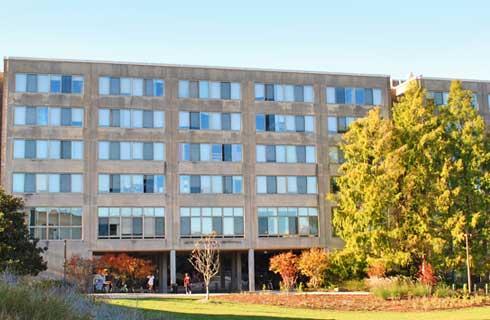先进材料博士学位
PhD Mechanics of Advanced Materials

学历文凭
Ph.D.

专业院系
Materials

开学时间

课程时长

课程学费

国际学生入学条件
IELTS: 6.5 Overall with 6.0 in each individual element.
TOEFL iBT: Overall score of 92, with not less than 22 in each test
IDP—雅思考试联合主办方

雅思考试总分
6.5
了解更多
雅思考试指南
- 雅思总分:6.5
- 托福网考总分:92
- 托福笔试总分:160
- 其他语言考试:Pearson Test of Academic English (PTE)- 62 overall with no less than 55 in all subtests
CRICOS代码:
申请截止日期: 请与IDP顾问联系以获取详细信息。
课程简介
In the last two decades, Mechanics of Materials as a discipline has experienced a type of revival. The main reason for this has been a continuing introduction of new materials (or even their classes) with extraordinary microstructures, properties and performance. Carbon nanotubes, quantum dots, bulk metallic glasses and graphene are some of the examples. This revival process was additionally enhanced by an application-related drive to expose these-as well as previously known and used- materials to harsher conditions: high strains, strain rates, loads and temperatures as well as combinations of various loading and environmental factors. Recent developments in aerospace, energy, automotive and defence industries as well as in microelectronics were possible thanks to extended usability envelopes for various components and structures. The Mechanics of Advanced Materials Research Group carries out multi-disciplinary research into the response of advanced engineering and bio-materials to various types of external loading and environmental conditions, using a combination of analytical, numerical and experimental techniques. Analysis of deformation processes, damage evolution as well as failure initiation and development allows us to predict the properties, performance, reliability and structural integrity of modern materials and the components and structures made from them. Projects in this broad area are welcome. Among the materials we are currently working with are composites and nanocomposites, polymers and adhesives, steels and alloys, metallic glasses, biological and biomedical materials, hydrogels, materials for microelectronics, sports materials, ceramics and ceramic coatings, polymeric foams and non-woven fabrics.
相关申请
 预科
预科 奖学金
奖学金 实习机会
实习机会 在校学习
在校学习 跨境学习
跨境学习 校园授课-线上开始
校园授课-线上开始 在线/远程学习
在线/远程学习
学校排名

世界排名401
数据源:泰晤士高等教育世界大学排名
关于拉夫堡大学

拉夫堡大学自1909年以来,作为继续教育和高等教育机构,拥有悠久的成功历史。如今,它是英国乃至世界领先的教育机构之一。该大学每年为成千上万的学生提供一流的教育和学习体验,并始终位列英国前十(《完全大学指南》,2017-2026)。拉夫堡大学的体育学科享誉全球,并被评为全球体育相关学科最佳大学(《QS世界大学学科排名》,2017-2025)。该大学以其各学科卓越的教学质量而自豪,并招募了一支多元化、多国籍的学术团队,确保学生接受由专业且经验丰富的教职员工提供的多样化教育。大学为包括工程、设计、商业等在内的所有学科领域提供卓越的设施。学校包容性的校园热烈欢迎国际学生,并提供广泛的支持设施,帮助他们在整个学习期间安顿下来并茁壮成长。大学设施齐全,致力于为学生提供卓越的学术体验和有趣的学生生活方式。学校拥有多元化的学生会、轻松的学习和社交空间以及全面的学生支持服务。大学的主校区位于东米德兰兹郡的拉夫堡镇。该校区交通便利,可轻松前往周边大城市,并为学生提供愉快的学习体验所需的一切。第二个校区位于伦敦伊丽莎白女王奥林匹克公园。拉夫堡大学的伦敦校区专为研究生学习和研究而设立。拉夫堡大学伦敦分校汇聚了具有影响力的思想领袖、先锋研究人员和富有创造力的创新者,为学生提供英国最优质的研究生学习体验之一。
本校相关课程

会前课程C
学历文凭
English Language
开学日期
课程费用总额


博士学位体育,运动与健康科学
学历文凭
Ph.D.
开学日期
课程费用总额


PhD International Relations, Politics and History
学历文凭
Ph.D.
开学日期
课程费用总额


物理学博士
学历文凭
Ph.D.
开学日期
课程费用总额


机械,电气与制造工程博士学位
学历文凭
Ph.D.
开学日期
课程费用总额


博士数学科学
学历文凭
Ph.D.
开学日期
课程费用总额

其他相关课程

工程学硕士(采矿)
 阿德莱德大学
阿德莱德大学学历文凭
Masters Degree (Coursework)
开学日期
课程费用总额


专业工程学硕士(化学和生物分子)
 悉尼大学
悉尼大学泰晤士高等教育世界大学排名:60
学历文凭
Masters Degree (Coursework)
开学日期
课程费用总额


工学学士(荣誉学位)(化学)
 阿德莱德大学
阿德莱德大学学历文凭
Bachelor Degree with Honours
开学日期
课程费用总额


石油工程研究生文凭
 科廷大学
科廷大学泰晤士高等教育世界大学排名:201
学历文凭
Graduate Diploma
开学日期
课程费用总额


工学学士学位(石油工程)(荣誉学位)
 科廷大学
科廷大学泰晤士高等教育世界大学排名:201
学历文凭
Bachelor Degree with Honours
开学日期
课程费用总额


加工厂技术文凭
 西澳大利亚州职业技术学院
西澳大利亚州职业技术学院学历文凭
Diploma
开学日期
课程费用总额





















 英国
英国




